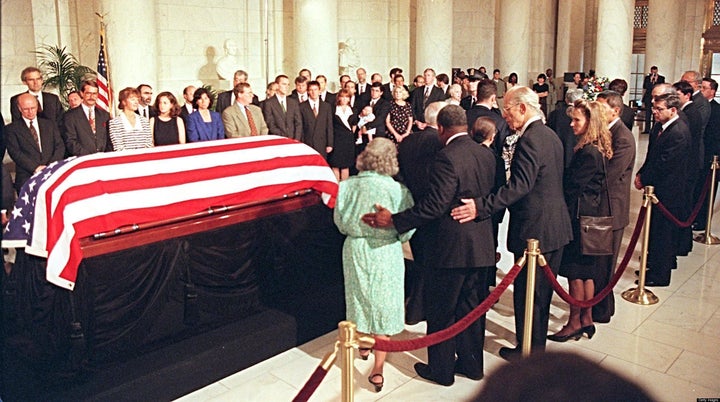
Review of "Justice Brennan: Liberal Champion." By Seth Stern and Stephen Wermiel. Houghton Mifflin Harcourt. 674 pp. $35.
Every fall, throughout his tenure on the U.S. Supreme Court, William Brennan asked his new clerks to identify the most important thing they needed to know as they began work in his chambers. Before the mystified neophytes could respond, he held up five fingers. With five votes out of nine, he explained, you could accomplish just about anything.
More often than not, from the mid-1950s to the mid-'80s, Brennan commanded a majority. The master strategist -- and tactician -- of the liberal bloc of the Court, he presided over a revolution in constitutional law. His legacy, according to Seth Stern, a reporter for Congressional Quarterly, and Stephen Wermiel, who covered the Court for The Wall Street Journal for twelve years, includes an expansion of the scope of the Bill of Rights, by applying its provisions to state legislation; a redefinition of the meaning of equality under the equal protection clause of the Fourteenth Amendment, with profound implications for the rights of minorities and women; protection of free speech, including flag burning; and stewardship over the rights of accused and convicted criminals.
Drawing on interviews with Brennan, who died in 1997, thirteen of his fellow justices and more than one hundred of his clerks, the "case studies" he recorded in the heat of the moment, and a careful review of his decisions, Stern and Wermiel provide a richly detailed portrait of the improbable transformation of a judge from New Jersey, plucked from relative obscurity by President Eisenhower, a Republican, into one of the most influential liberal justices in the twentieth century; an anatomy of the inner workings of the Supreme Court; and a provocative analysis of the impact of "judicial activism."
To attract a majority, Stern and Wermiel point out, Brennan at times sacrificed conceptual clarity and consistency. But compromise, it seems to me, comes with the territory. More important, and more compelling, is the case they make that he and his liberal colleagues (on and off the Court) did not adequately anticipate or address criticism (that was by turns impertinent, inapplicable, practical, and probing, but always politically potent) that they were constituting themselves as a third legislative house, stretching the language of the Constitution to enshrine their own policy preferences into law, and thereby thwarting the will of the democratically elected representatives of the people.
Brennan, Stern and Wermiel remind us, was the poster boy for judicial activism, with a tendency to overreach. Because the death penalty "did not comport with human dignity," he argued, it resulted in cruel and inhuman punishment -- and was therefore unconstitutional under all circumstances. Even though, at the time, over forty states had capital punishment statutes and, according to most polls, supporters outnumbered opponents. Human dignity, the authors suggest, is an amorphous concept; it represented a moral vision, not a legal standard. Little wonder, then, that many critics thought the issue best left to legislatures. Or that conservative politicians had a field day accusing the Court of being soft on crime.
Another example: in his zeal to protect welfare recipients from arbitrary action by government officials, Brennan looked for a way to classify benefits so that due process applied -- and tried to define them not as a gift but as an entitlement, included within the right to own (and retain) property. To get a fifth vote for a decision that compelled bureaucrats to provide specific reasons for cutting off benefits and an appeals process, he backed down a bit. But not nearly enough to keep Justice Hugo Black from opining that "today's result does not depend on the language of the Constitution itself or the principles of other decisions."
These days, Stern and Wermiel conclude, judicial activism seems to belong "to a bygone era." They may be right. And it may well be that the courts cannot - and should not - be relied on so heavily to bring about social change. But important questions are left unanswered in Justice Brennan. What substantive decisions and which core concepts of the jurisprudence of the 1960s and '70s should endure? Do they include, for example, the right to privacy? And should we attribute the demise of liberal jurisprudence to its excesses and inherent deficiencies, as the authors imply, or to the backlash against Great Society liberalism and the rhetorically appealing critique of advocates of "original intent," which is, it should be noted, a disguised form of (conservative) judicial activism?
Unhappy -- and ineffective -- in dissent in the 1990s, Brennan took some comfort in a belief that the pendulum would swing back toward liberalism in the not-too-distant future. "The big strength of society," he declared, is that "we don't remain one way or the other forever." Perhaps. But some pendulums -- especially when they're carrying a philosophically sound and politically salient liberal jurisprudence -- require a push. At the moment, alas, liberals seem to be in despair, out of gas, and anything but pushy.
